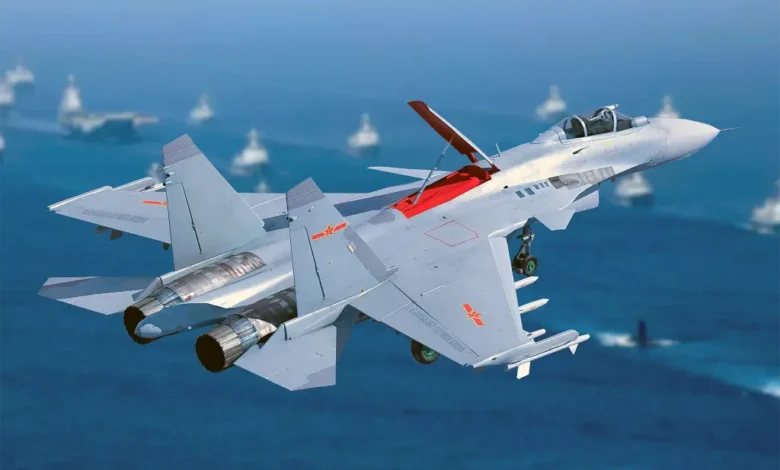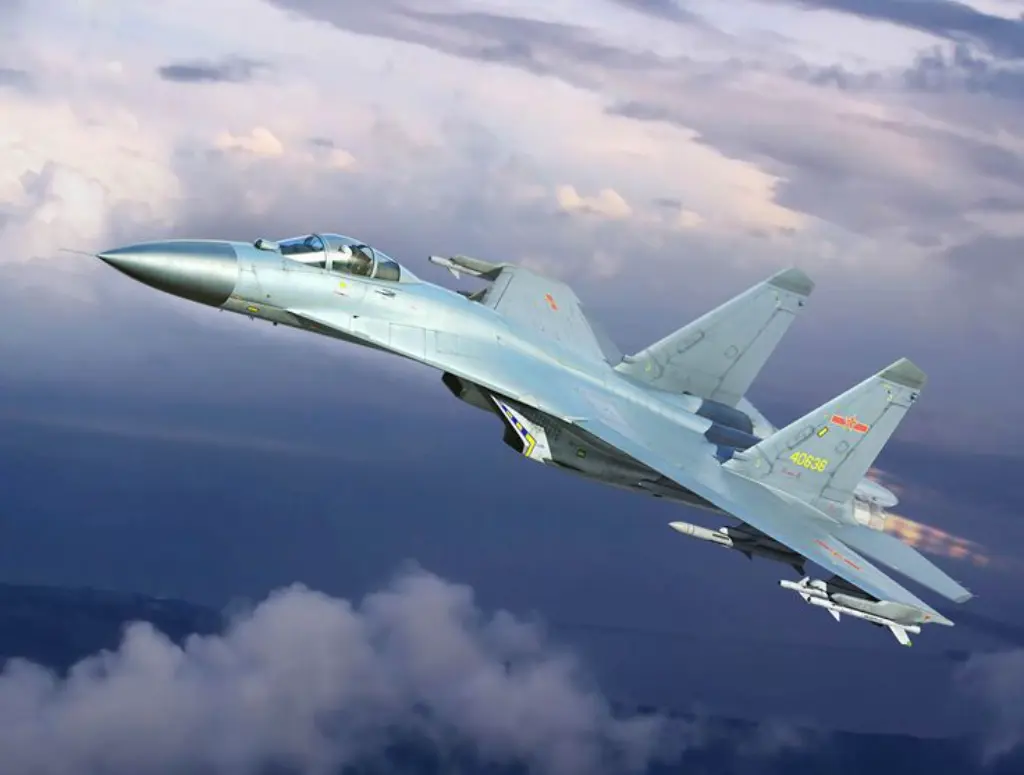Shenyang J-11

The Shenyang J-11 is a twin-engine, air superiority fighter developed by Shenyang Aircraft Corporation for the People’s Liberation Army Air Force (PLAAF). Based on the Russian Sukhoi Su-27, the J-11 has been domestically produced and upgraded with Chinese avionics, weapons systems, and engines. First introduced in 1998, the J-11 is designed for air superiority and multirole missions, with variants capable of ground attack and advanced combat roles.
Fact Sheet
| Role | Air superiority and multirole fighter |
|---|---|
| Manufacturer | Shenyang Aircraft Corporation |
| First Flight | 1998 |
| Service Entry | 1998 |
| Crew | 1 |
Specifications
| Length | 21.9 m (72 ft) |
|---|---|
| Wingspan | 14.7 m (48 ft 3 in) |
| Height | 5.93 m (19 ft 5 in) |
| Empty Weight | 17,000 kg (37,478 lb) |
| Max Takeoff Weight | 33,000 kg (72,752 lb) |
| Powerplant | 2 × WS-10A turbofans |
| Thrust | 27,560 lbf (122.6 kN) per engine with afterburner |
| Max Speed | Mach 2.35 (2,500 km/h; 1,550 mph) |
| Service Ceiling | 19,000 m (62,000 ft) |
| Range | ~2,000 mi (3,200 km) combat radius |
| Rate of Climb | ~65,000 ft/min (330 m/s) |
Avionics & Armament
| Main Radar | Type 1473 radar |
|---|---|
| Avionics | Advanced avionics suite, electronic warfare systems |
| Armament | One 30-mm cannon; Up to 10 external hardpoints for: – Air-to-air missiles (PL-8, PL-12) – Air-to-ground munitions (bombs, rockets) – Precision-guided bombs – External fuel tanks |
Notable Features
- Based on the Su-27 with domestic upgrades.
- Multirole capability for air-to-air and air-to-ground missions.
- Advanced avionics for superior situational awareness.
- High maneuverability for dogfighting superiority.
- Continuously upgraded with new variants like the J-11B and J-11D.

The Shenyang J-11 (Chinese: 歼-11; NATO reporting name: Flanker-B+/Flanker-L) is a series of twin-engine, multi-role fighter aircraft developed and produced by the Shenyang Aircraft Corporation (SAC) in China. It is based on the Soviet-designed Sukhoi Su-27SK air superiority fighter, initially built under license and later significantly indigenized and upgraded with Chinese systems.
Origin and Development
The story of the J-11 is rooted in China’s desire to modernize its air force and gain access to advanced fighter technology in the 1990s.
- Licensed Production (J-11 / J-11A): In the mid-1990s, China signed a deal with Russia to license-produce the Su-27SK, an export version of the Su-27, at the Shenyang Aircraft Corporation. The initial batch of J-11s (sometimes referred to as J-11A) were essentially assembled from Russian-supplied kits, incorporating Russian engines and avionics. Around 100 of these were built.
- Indigenous Development (J-11B and beyond): However, China soon began to integrate its own technologies into the J-11 design, ultimately leading to a controversial situation with Russia, which viewed this as an unauthorized reverse-engineering and violation of the licensing agreement. The J-11B became the first truly indigenous variant, incorporating:
- Chinese Avionics: This included a new, domestically developed multi-mode radar (Type 1493), a glass cockpit with multi-function displays, a helmet-mounted sight, an onboard oxygen generation system (OBOGS), and improved electronic warfare systems.
- Indigenous Engines: Crucially, the J-11B began to use the Chinese-developed Shenyang WS-10 “Taihang” turbofan engine, aiming to reduce reliance on Russian AL-31F engines. While early WS-10s reportedly had reliability issues, they have since matured.
- Lighter Airframe: Increased use of composite materials in the airframe made the J-11B slightly lighter.
- New Weaponry: Integration of Chinese air-to-air missiles like the PL-8, PL-9, and later, the active radar-guided PL-12.
The J-11B was delivered for testing in 2006 and entered service with the PLAAF subsequently, despite the ongoing disputes with Russia over intellectual property.
Key Features and Capabilities
The J-11, particularly its later variants, is a highly capable 4th/4.5th generation fighter:
- Air Superiority Focus: Like its Su-27 progenitor, the J-11 maintains excellent speed, range, and maneuverability, making it well-suited for air superiority missions.
- Twin-Engine Power: Powered by two turbofan engines (either Russian AL-31F or indigenous WS-10 series), providing substantial thrust for acceleration and climb.
- Long Range: Inherits the Su-27’s large internal fuel capacity, giving it a combat range of over 1,000 km and a ferry range of over 3,500 km.
- Radar and Sensors:
- Early J-11s used Russian N001 radar.
- J-11B features the Chinese Type 1493 radar.
- Later and more advanced variants, like the J-11D, are believed to incorporate Active Electronically Scanned Array (AESA) radar for enhanced detection, tracking, and electronic warfare capabilities.
- Includes an Infrared Search and Track (IRST) system for passive target detection.
- Heavy Armament: The J-11 has 10 hardpoints capable of carrying a significant payload of up to 9,000 kg (nearly 20,000 lbs).
- Air-to-Air Missiles: R-73, R-27, PL-8, PL-9, PL-12. More advanced J-11 variants (like J-11D) can carry the very long-range PL-15 active radar-guided missile and the advanced short-range PL-10 IIR missile.
- Air-to-Ground Capability: While primarily an air superiority fighter, later multi-role variants (J-11B and onwards) can employ unguided rockets, free-fall bombs, and potentially precision-guided munitions.
- Internal Cannon: A 30mm GSh-30-1 cannon.
- Glass Cockpit: Modern J-11 variants feature a “glass cockpit” with multi-functional displays, reducing pilot workload and improving situational awareness.
Key Variants
The J-11 family is extensive due to continuous upgrades and specialized roles:
- J-11 / J-11A: Initial licensed-built versions from Russian kits, with incremental Chinese content and avionics improvements.
- J-11B (Flanker-L): The first fully indigenized variant with Chinese avionics, radar, and WS-10 engines. It also has multi-role capabilities.
- J-11BS (Flanker-L): A tandem two-seat combat-capable trainer version of the J-11B.
- J-11BH / J-11BSH: Naval variants of the J-11B and J-11BS, respectively, operated by the People’s Liberation Army Naval Air Force (PLANAF). These are generally land-based naval fighters, not carrier-capable in the same way as the J-15.
- J-11D: A highly advanced variant, considered a “4.5 generation” fighter. It reportedly features AESA radar, enhanced use of composite materials for reduced radar observability, improved electronic warfare systems, and compatibility with the latest Chinese missiles like the PL-10 and PL-15. It’s often seen as China’s equivalent to Russia’s Su-35. While development has been ongoing, its exact production status and numbers are unclear, with some reports suggesting its role might be filled by the J-16.
Operators and Combat History
- China (People’s Liberation Army Air Force – PLAAF and People’s Liberation Army Naval Air Force – PLANAF): The sole operator of the J-11 series. It forms a significant part of China’s fighter fleet, especially for air superiority and long-range interception.
Combat History: The J-11 has no confirmed combat kills in actual warfare. Its operational history largely involves training exercises, air policing missions, and intercepts of foreign aircraft.
- Intercepts: J-11s have been involved in numerous intercepts of foreign reconnaissance aircraft (e.g., U.S. Navy P-8 Poseidons) in the South China Sea and other contested regions. These encounters have sometimes been described as “unprofessional” or “unsafe” by foreign militaries due to close proximity or aggressive maneuvers.
The Shenyang J-11 represents a critical step in China’s indigenous military aviation development. It demonstrated China’s ability to not only assemble foreign designs but also to integrate and improve upon them with domestic technology, paving the way for more advanced indigenous designs like the J-16 and the stealthy J-20. It remains a backbone fighter for the PLAAF and PLANAF, especially the more modernized variants.



